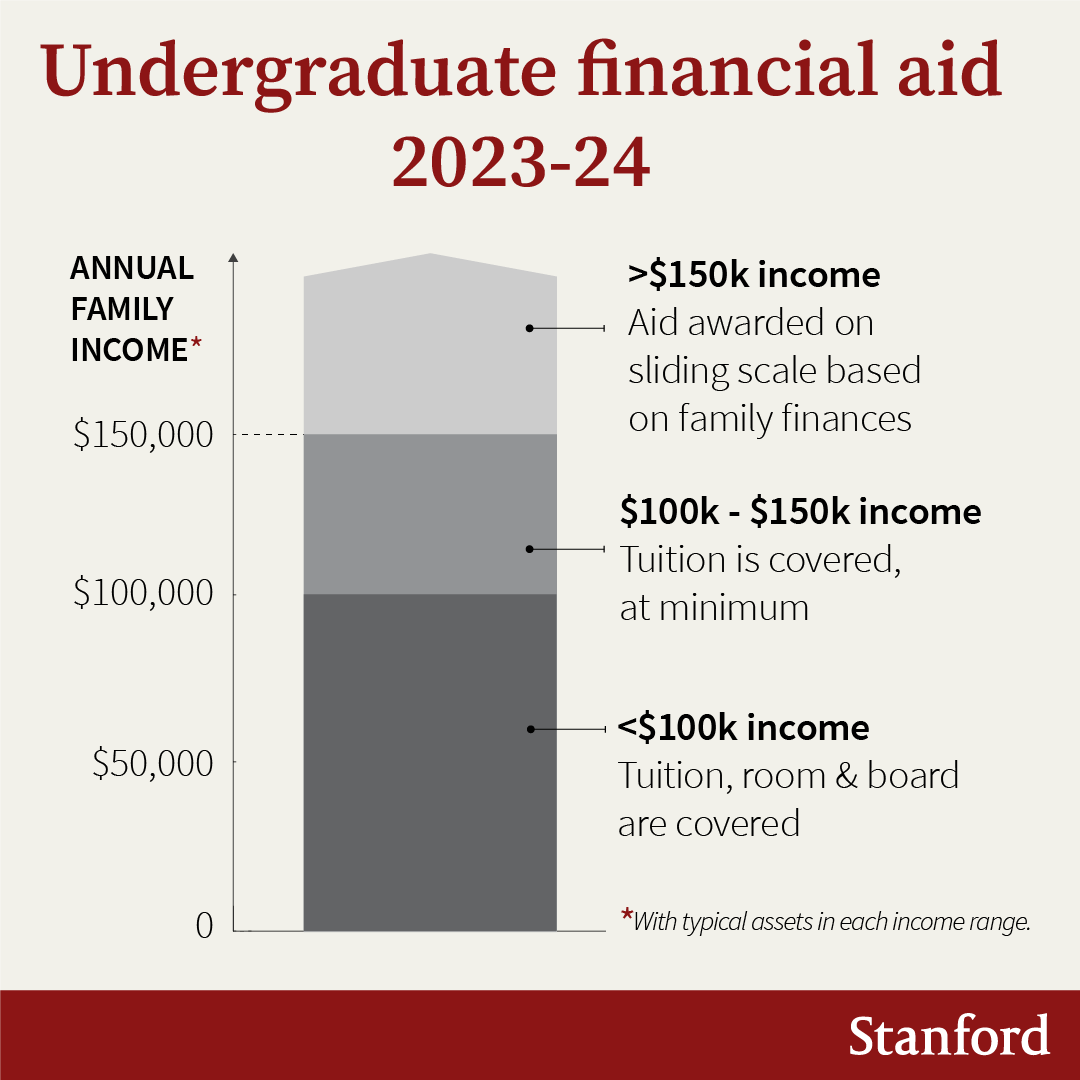Stanford will increase student financial aid, providing expanded scholarship funding so that undergraduate families with annual incomes below $100,000 will not have to pay tuition, room, or board beginning in the upcoming 2023-24 academic year, the Board of Trustees announced following its meeting this week.
The new $100,000 threshold compares to the current threshold of $75,000 below which undergraduate families at Stanford receive scholarship support to cover tuition, room, and board. Families with incomes below another threshold – $150,000 – will continue to receive at least enough scholarship support to cover tuition at Stanford.
“Stanford is committed to providing an affordable education for all students, regardless of their economic circumstances. We are pleased that this newest expansion of our financial aid program continues and extends that commitment,” said Jerry Yang, chair of the Stanford Board of Trustees.
For families who do pay tuition, trustees approved a 7% increase in undergraduate tuition for the 2023-24 academic year, seeking to support continued high-quality academic and student support programs amid the effects of high inflation on the cost of university operations. However, Stanford’s aid program will take into account the increase in tuition for current students receiving need-based financial aid; those whose family financial circumstances do not change can expect to pay the same amount they do this year, and possibly less for those with family incomes under $100,000.
Continued commitment to student aid
Stanford’s undergraduate admission process is need-blind for U.S. applicants, and the university commits to providing the necessary financial support for any admitted student to attend.
The university has expanded its financial aid program several times in recent years, and today its features include:
- More than two-thirds of Stanford undergraduates receive some form of financial aid from internal and external sources, including athletic scholarships.
- In fall 2022, first-year students who were awarded need-based aid received an average annual scholarship of more than $62,000 from Stanford.
- 86% of students graduate with no student debt.
- Stanford excludes home equity from the calculation of parental contribution toward the costs of attending, benefiting many families.
As part of this aid program, for many years Stanford has committed to providing sufficient scholarship support so that parents with annual incomes below a certain threshold, and assets typical of that income level, are not expected to contribute toward tuition, room, or board. This income threshold will increase to $100,000 beginning in 2023-24.
Stanford also requires no parental contribution toward tuition from families with annual incomes below $150,000 and typical assets. Many students with family incomes above the $150,000 threshold also are eligible to receive Stanford scholarship support, awarded on a sliding scale based on family financial circumstances. (These levels are set based on cost of living in the United States and may not apply to families living in other countries; aid eligibility is determined based on individual family circumstances.)
Undergraduate tuition and fee levels
Tuition provides core support for Stanford’s academic programs, faculty and staff compensation, student services, and financial aid, as well as infrastructure and other support services. However, tuition only covers a portion of the university’s cost of educating each student. Undergraduate tuition was kept flat in 2021-22 and increased 4% in 2022-23.
Along with the 7% increase in the tuition rate for 2023-24, charges for room and board will increase 7% for those who pay these charges, supporting inflation-driven cost increases in food and materials as well as compensation for critical housing and dining staff. Stanford’s financial aid program will cover the increased costs for families currently receiving need-based aid if their financial situations remain the same.
Total undergraduate charges for full-tuition–paying families will be $82,406 in 2023-24, including $61,731 for tuition, $19,922 for standard room and board, and $753 for the mandatory health fee. As noted above, a large proportion of Stanford students do not pay the full price, receiving significant offsetting amounts of financial aid.
Tuition and financial support for graduate students
Graduate and professional programs have different tuition rates, but general graduate tuition will increase by 4% in 2023-24 under the trustees’ action. (Doctoral students are not responsible for paying tuition in years 1–5; it is paid on their behalf through a variety of funding sources and mechanisms.)
Specific tuition levels for graduate and professional programs will be posted to the Student Services website later in the year.
Stanford continues working to support graduate student affordability. The university in recent years has expanded the availability of on-campus housing and committed to providing 12-month funding for up to five years for all doctoral students in good academic standing. Stanford also increased the health insurance subsidy to 100% for graduate students who are supported on research and teaching assistantships, or an equivalent level of fellowship, and increased to a maximum of $20,000 per year the Graduate Family Grant providing support for individuals with dependent children to help cover expenses such as child care, health care, and rent.
